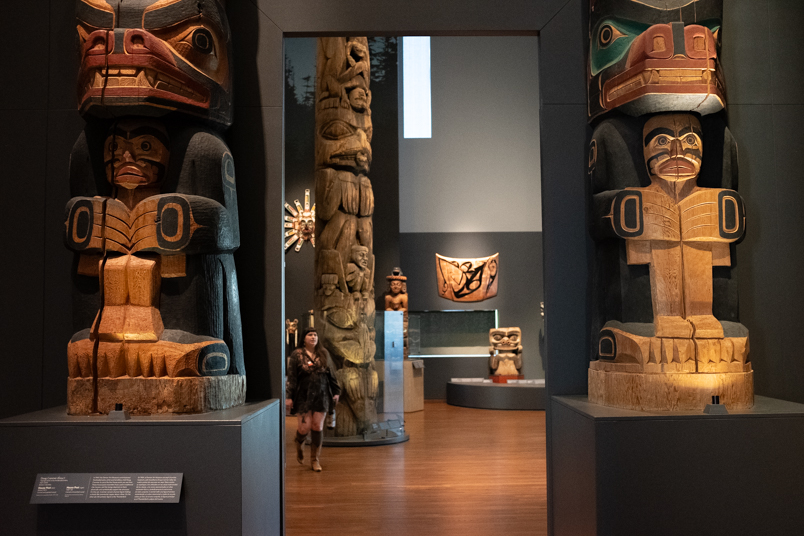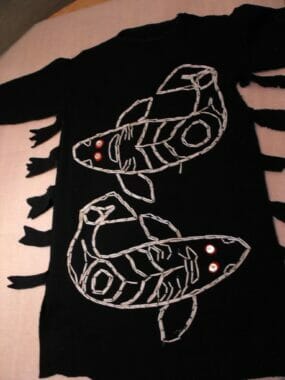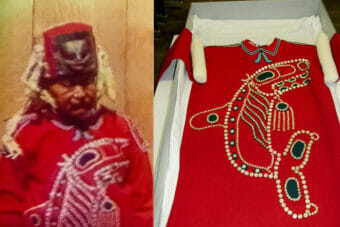
Earlier this month, the Denver Post reported that Lingít tribal members have been requesting cultural items back from the Denver Art Museum in Colorado for years — to no avail.
The museum holds many Lingít items that may qualify to be returned under federal law.
Investigative reporter Sam Tabachnik says delegates from the Central Council of the Tlingit and Haida Indian Tribes of Alaska sought the return of five items, including a 170-year-old clan house partition featuring the Naanya.aayí clan crest.
One Tlingit and Haida cultural resource officer told Tabachnik that the Denver Art Museum was “probably the worst museum” they had dealt with. And Tabachnik says the museum has a history of denying repatriation requests.
Listen:
This transcript has been edited lightly for clarity.
Sam Tabachnik: With the passage of NAGPRA, the Native American Graves Repatriation Act in 1990, American museums were required to compile inventories of all their Native American objects that may be subject to the act. This includes ancestral human remains. It includes associated funerary objects, objects of cultural patrimony, and a few other categories. And so these museums had to go through their collections and try and figure out what might be subject to the law.
The Lingít tribe had sort-of, off-and-on conversations with the Denver Art Museum over the years. They submitted three formal claims for various objects in the early 2000s. But it was really this meeting in 2017 that kind of, I think, really put the relationship between the tribe and the museum into, kind of, stark focus.
It was a three-day set of meetings here in Denver. There were about a dozen tribal members who came from Alaska to talk with the museum.
It was on this third day, you know, from talking to people who were in this meeting, that the tone really started to shift. Now, the museum says this shift occurred when museum officials were talking about the necessary process that the tribe would have to go to, in order to comply with NAGPRA, in order to file an official claim that might be accepted by the museum.
Tribal members told me that they viewed this meeting in particular, as incredibly, uh — Denver officials were incredibly condescending, insensitive, and seemingly intransigent. Unwilling to really budge.
Yvonne Krumrey: And what has taken place in the last seven years since it’s happened?
Sam Tabachnik: You know, it’s unclear. There has not been a lot of movement here. The museum says the tribe has not submitted formal claims for a couple of the pieces I talked about in the article. And so the museum says, “Hey, you know, we’re just waiting on a formal claim.”
The tribe says, “Well, the museum has been quite clear in their discussions that even if we submitted a formal claim, that they would not return these objects.” So I think the tribe has sort of taken the impression that this is just not gonna happen.
Yvonne Krumrey: And from your reporting, and speaking with tribal members and the museum officials, what are some of the barriers to the process of submitting these formal claims? Is it fairly straightforward? Or are there, kind of, hoops to jump through to do it?
Sam Tabachnik: There are a number of different qualifications or categories that tribes are supposed to fill out, or they’re supposed to show evidence to check off certain boxes.
ProPublica published a really impressive project about NAGPRA in the last year called the Repatriation Project, and it essentially showed how museums — 33 years after the lawʼs passage in 1990 — still half of these funerary objects and human remains are still in some of America’s most prestigious universities and museums.
It is that museums really hold the cards here. They have control of these objects, and they can make it as easy or difficult as they want.
Yvonne Krumrey: And you said that there are still a couple items that there hasn’t been a formal request process for. What has happened with the ones that have been formally requested?
Sam Tabachnik: Yeah, so the museum told me there were three formal claims from the Lingít tribe. Two were rejected for not having enough information — for not checking all the boxes of, you have to prove that a single individual could not give up the rights to an object, that it had to be collective ownership. There are several other categories you have to hit. And the museum said the tribe wasn’t able to prove certain things. And so they rejected them. The third one, they said they didn’t get even enough information from the tribe in the claim. They were unable to initiate a formal evaluation process. So in all essence, they rejected three claims from the tribes.
Yvonne Krumrey: How do Denver Art Museum’s actions compare to other museums that have had this experience or have gone through this process?
Sam Tabachnik: Yeah, so Colorado has generally been viewed as a national leader in complying with NAGPRA, the Denver Museum of Nature and Science has been incredibly proactive. History Colorado has been also cited by some national folks as really leaders in the field. They kind of went above and beyond. A lot of museum folks talk about the difference between complying with the letter of the law and complying with the spirit of the law. And several of these Colorado institutions really wanted to comply with the spirit of the law. And people have spoken about how the Denver Art Museum has not been a part of that. They have not been as proactive as other museums.
Yvonne Krumrey: You’ve reported on Denver art museums ownership of contested items before. Can you tell me a bit about that reporting?
Sam Tabachnik: Sure, I’ve been writing about the Denver Art Museum and repatriation requests or claims for about three years. I spent a long time — wrote a long series about a former now deceased museum consultant and board member named Emma Bunker, who was tied in with the antiquities trafficking and organization essentially. And she helped the museum acquire a host of Southeast Asian antiquities that the Southeast Asian countries — Cambodia, Thailand, Vietnam — said were looted from their ancient temples.
Yvonne Krumrey: In your understanding of this landscape with the Denver Art Museum, how does the story fit into a broader pattern of them holding items that are contested or maybe weren’t acquired in honest means?
Sam Tabachnik: Yeah, what the Lingít tribe reported to me jives with what other countries have told me about the reluctance of the museum to give up objects in their collection. I thought it was telling — the curator of Native American arts who I interviewed I sat down with as part of this latest story said, “We’re not in the business of just giving away our entire collections.” And I thought that quote was an interesting quote and spoke volumes.



